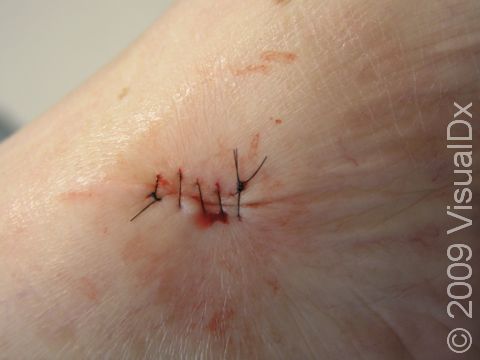Suture, Surgical
Sutures, commonly called stitches, are synthetic or animal gut-derived threads used to close a wound after a surgical procedure or injury. A variety of sutures exist that vary in size, strength, and durability. Stitches placed deep inside the wound always require the use of dissolvable (absorbable) sutures, whereas stitches visible on the skin may be dissolvable or nondissolving (nonabsorbable) sutures.
Sutures are used to:
- Repair a cut or scratch of the skin (laceration).
- Close an open area of skin after surgery.
- Hold a skin graft in place.
Pulling the skin together with sutures helps lessen healing time, decreases the surface area of the resultant scar, and reduces risk of infection.
What to Expect During Your Visit
In the case of a laceration or following surgery, you will be placed in a comfortable position and the affected area will be cleaned with an antiseptic solution. The wound is often irrigated with sterile water to clean out any debris or bacteria. The medical professional will inject a numbing solution (most likely lidocaine) into the skin so that the suturing will not be painful.
Depending on the depth of the wound, you may require a deep layer of stitches prior to the placement of the surface stitches. Placing a suture involves using a long thread with a curved needle at one end. The end with the needle is held by a special tool called a needle driver, which looks like a pair of scissors with clamps to hold the needle, instead of blades. The medical professional holds the needle driver and uses the needle to insert the thread into each side of the wound. They then pull the thread, which brings the skin together, and then tie knots.
Once the sutures are placed, a pressure dressing is applied. Your medical professional will discuss wound care instructions to follow at home.
What to Expect After Your Visit
After getting stitches, you should see that the wound or laceration is closed, and you may be able to see the threads of the sutures. There may be some mild redness in the area at first. There may be pain after the local anesthetic wears off, but this can be controlled with a pain reliever such as acetaminophen (eg, Tylenol).
Follow-Up Care
Follow your medical professional’s instructions for at-home wound care. Avoid getting the wound wet during the following 24-48 hours. Petroleum jelly (eg, Vaseline) or antimicrobial ointment may be applied daily with a clean gauze dressing or a bandage applied until the wound heals. In the case of nonabsorbable stitches, you may need to go back for removal in 5-14 days.
Risks and Potential Side Effects
Risks associated with sutures include:
- Infection.
- Allergic reaction.
- Scarring – Sometimes a keloid forms, which is more common in people with darker skin colors.
- The stitch may fail, causing the wound to reopen (dehiscence).
- A deep stitch that “splits” (extrusion).
When to Seek Medical Care
Contact your medical professional if you experience:
- A stitch that splits.
- Signs of an infection (eg, oozing from the sutures, pain, spreading redness, or fever).
Trusted Links
References
Kantor J. Suture materials and needles. In: Kantor J. Dermatologic Surgery. McGraw-Hill Education; 2018.
Singer AJ, Hollander JE. Wound closure. In: Tintinalli JE, Ma OJ, Yealy DM, Meckler GD, Stapczynski JS, Cline DM, Thomas SH, eds. Tintinalli’s Emergency Medicine: A Comprehensive Study Guide. 9th ed. New York, NY: McGraw-Hill Education; 2019.
Last modified on June 24th, 2024 at 2:02 pm

Not sure what to look for?
Try our new Rash and Skin Condition Finder
